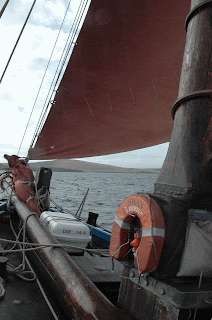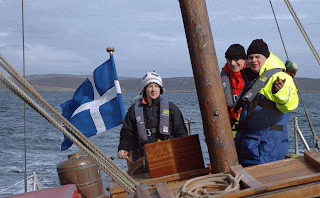I have been forced into action. On Saturday we went for a day sail, and it
ought to be easy to write an account of it but I am suffering from writers
block. Until a month ago I was a
recreational sailor. I sailed for
pleasure and I suited myself, my decisions, my choices. And whilst I believe I am a responsible
sailor, I was responsible to no one but myself and my crew. I could simply write about the pleasures of
sailing. Not so now. As a commercial seafarer, I am subject to and
must comply with a statutory regulatory framework. (E-mail me for a full list of the appropriate
documents!) Fundamentally there is
little change, if you have been making responsible decisions at sea, then
recreational or commercial should make no difference. However it is different; Saturday’s sail was
about volunteer sea staff training.
Sea staff are volunteers and give off their time and
experience for a variety of reasons. A
common one is that like me they enjoy sailing.
However their volunteering must encompass more than recreational
sailing. Avoiding a detailed discussion
on the legal framework, and cutting to the chase, as well as enjoying
themselves, they also need to be trained.
A great deal of discretion exists with regard to the latter but there
are some red lines, which I am required to comply with. I don’t know that anyone was expecting to
enjoy a lazy day sail, but if they were, then they would have been
disappointed. Of course the holy grail
is to keep it fun, thus encouraging them to return, whilst at the same time
delivering the “documented and structured” training required by the MCA. I hope I got the balance right; proof will
be as to how many turn up next weekend.
Alongside we did four separate exercises or lessons. Firstly, we looked at the anchor and
windless. The windless is a manual hand
turned one and although not normally thought of as a safety system, it can be
and in any case needs to be handled safely as heavy chain, cogs and fingers can
be an undesirable mixture. Going below
for coffee, we embarked on the first part of a lesson on mainmast running
rigging which included how the various halyards and hardners interact and tie
off. Then it was back on deck for a
practical familiarisation, including identification of ropes, overhauling
tackles and by way of confirmation “teaching” the same to each other. Bythen it was time for a warm up, so down to
the engine room to run through engine checks and starting. The engine is
not normally thought of a s a safety system but it is not hard to imagine a
scenario when it is precisely that! We
now came to the infamous MOB or man over board.
MOB is an interesting example of how we manage or mismanage perceptions
of risk and safety. I have developed some
firm and contentious views on the same. The
Trust has an unambiguous policy of always wearing life jackets. As an employee, I comply and as skipper, I
set an example. My views on life jackets
are not always understood and sometimes I sense that people perceive me as being
“pig (or big) headed” on the subject. Last
year I was on a boat were the skipper insisted on us all wearing life jackets
but had no pump or bailer. Frankly on
that particular occasion, I’d have swapped a lifejacket for a bailer or pump,
or even some engine tools. Any of the
last three, would have made for far greater safety. When challenged, the skipper insisted that
because we wearing life jackets we would be safe even if the boat flooded or
the engine failed. It was a classic example
of feeling or looking safe but actually having utterly misunderstood the
balance of risk. We would have had to try
very hard to accidently fall overboard, but an open boat without a means of shifting
water is an accident waiting to happen.
The engine was our only means of propulsion and we would have been
literally “up the creek without a paddle” if it had failed. So my point is that an over emphasis on
safety being achieved by wearing a life jacket can be a barrier to a balanced
risk analysis and paradoxically life jackets detract from rather than enhance safety. An example being those whose thinking runs "if I wear a life
jacket then I am safe because have adopted a safe practice" In fact they have completely misunderstood the reality of
MOB.
Meet Fred. . . . .
Fred is Scalloway harbour authority’s man sizes/weight floating dummy. Even if a real life Fred was conscious when I managed to successfully bring the 65 ton Swan to a halt next to him, the chances are that he would be incapable of scrambling up a boarding ladder or net let alone grabbing a rope and securing it to himself so that we could haul him aboard. So with Fred lying in the inflatable to simulate him floating on his back, we considered how exactly we could attempt to get him back on board over Swan’s four foot freeboard. There are many aspects of my former career that I cannot unequivocally defend or justify but one area in which the Army typically excel is realistic training that emphasises bridging a theoretical or classroom skill with the reality of practical application and rehearsal in a near realistic environment. Using this technique, we spent a most interesting and informative hour discussing and enacting ways of getting to Fred and lifting him to the deck. I for one learnd a lot and it has allowed me to develop some ideas and also to make some recommendations to the operating committee on additional equipment and adaption of current equipment.
After a bowl of reviving soup, it was finally off for a sail and a chance to put those mainmast running rigging ropes to work!! I’m now becoming more comfortable with Scalloway harbour entrance and the channels that lead out past rocks and fish farms. Having cleared the entrance we hoisted the foresail, and tensioned the luff with the hardner. Still under engine we ran on a broad reach for a few miles before gybing and hoisting the main.
The foresail drawing
The main is an impressive sail and her gear
is heavy and over gauge but its all good for the “full upper body work out” as
teams sweat the peak and throat to raise the gaff and sail. It’s a far cry from the convenience of winches
on modern yachts and whilst it can be viewed as crude and backbreaking work, it
is also a tribute to a forbearers’ ingenuity that they devised a system that
allowed a few men to hoist aloft over a ton of gear. Now because this post is meant to be about
sailing I shall desist on elaborating on two thoughts about “frames of reference”
and sea shanties. . . . but watch this space!
A small part of the Main Showing Swan's fishing registration
With the main hoisted we were final able to kill the “iron
topsail” as the engine is sometimes called and enjoy some quiet. Most of the crew had the opportunity to helm
and we spent an all too short time tacking and gybing.
The helm committee
I enjoyed this but as a new skipper and very conscious
of my inexperience and responsibility it was not relaxing. I’m still learning about the Swan and
navigation takes a goodly proportion of my time. All too soon it was time to drop sail and
return to the quayside. The wind ensured
it was my most difficult “park” if you are not nautical or “lay alongside” if
you are. It actually involved dropping a
crewman ashore on an easier (leeward) berth and as he walked around to our
berth, I came off and onto our windward berth.
Scott both assisted me greatly and then congratulated me. I’m reminded of an old army adage that you
can conceal your incompetence from your superiors far more easily than from
your subordinates. Scott’s praise is
high praise indeed. Not that it is one
way. He is stepping up fantastically and
his ability to instruct and organise novice crew is growing rapidly.
Sail Handling. Note Nat, one of his roles is to make me look like a wimp
I really hope (and believe) that people will return next
weekend. I sensed that everyone learnt
something and felt that their time had been spent beneficially. There is no reason that learning should be restricted
to an activity for the young and an important lesson in seamanship and life is
to recognise who little you know and to do something about it.





Hi Richard, it's a really interesting blog spot. Very well written and fun to read. Hope you can keep it going. All best wishes Nicky.
ReplyDeleteThanks Nicky, for those who don't know Nicky is chairman of the Colne Smack Preservation society. I am an absentee member of his committee. My open day/estuary clinker built boat "Hope"lies there. and its full of Smacks and Bawleys from teh East Coast.
ReplyDeletesee www.colnesmack.co.uk for more detail
Just thought you might like to know...Caroline the CDPS press officer and owner of the large smack Pembarth, has booked a place in the smack dock at B'sea for her partner's Zulu soon to be relaunched after a long restoration. Surely a lovely reflection of the Scottish fishing industry's past role, as the lugger fleet followed the herring shoals south down the coast every year.
ReplyDeleteWe look forward to seeing her. Thanks for the blog - it's great reading for us soft southeners!